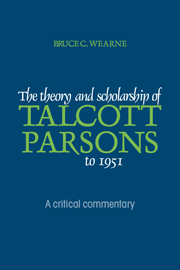Book contents
- Frontmatter
- Contents
- Preface
- Part 1 Unravelling Talcott Parsons' theoretical development
- Part 2 Talcott Parsons: the roots of his thought
- 2 Talcott Parsons in relation to the thought of his time
- 3 The Amherst Papers
- Part 3 The development of theory
- Part 4 The theory
- Part 5 Parsons' theory as it stood at 1951
- Appendix Some recent publishing on Talcott Parsons' theory: a bibliographical essay
- List of references
- Index of names
- Index of Parsonian concepts
2 - Talcott Parsons in relation to the thought of his time
Published online by Cambridge University Press: 05 February 2012
- Frontmatter
- Contents
- Preface
- Part 1 Unravelling Talcott Parsons' theoretical development
- Part 2 Talcott Parsons: the roots of his thought
- 2 Talcott Parsons in relation to the thought of his time
- 3 The Amherst Papers
- Part 3 The development of theory
- Part 4 The theory
- Part 5 Parsons' theory as it stood at 1951
- Appendix Some recent publishing on Talcott Parsons' theory: a bibliographical essay
- List of references
- Index of names
- Index of Parsonian concepts
Summary
Was this man a Calvinist?
Future biographers of Talcott Parsons might ponder the likelihood that his birth was not a ‘meticulously planned’ event. He was the sixth and youngest child in his family, considerably younger than the next youngest. His father, Edward Smith Parsons (1863–1943), was a ‘Congregationalist’ minister of ‘calvinistic’ orientation, who came from a long line of Yankee merchants. According to Martel he ‘broke family tradition’ by attending Yale Divinity School and becoming a Congregationalist minister (Martel 1979: 609–10). It is of note, however, that the ‘Smith’ in Talcott's father's name was given in remembrance of Edward Parmelee Smith (1827–76). Talcott's paternal grandmother was Smith's cousin. This man, also a Congregationalist minister, was general field agent for the US Christian Commission during the Civil War, general field agent for the American Missionary Association after the Civil War, later US Commissioner of Indian Affairs, and still later President of Howard University (Armstrong 1983).
Edward S. Parsons became an independent scholar of social gospel orientation, and specialized in the literary study of Milton (E. S. Parsons 1903). He wrote articles and books on various themes: religious, social and literary (E. S. Parsons 1889; 1904; 1912). Like E. P. Smith he became an academic administrator.
But E. S. Parsons was not a ‘strict’ Calvinist. Massachusetts Congregationalism, weakened through its controversy with Unitarianism, had dispensed with any ‘calvinistic’ formulae in the middle of the nineteenth century (Meyer 1964: 80).
- Type
- Chapter
- Information
- The Theory and Scholarship of Talcott Parsons to 1951A Critical Commentary, pp. 11 - 18Publisher: Cambridge University PressPrint publication year: 1990



